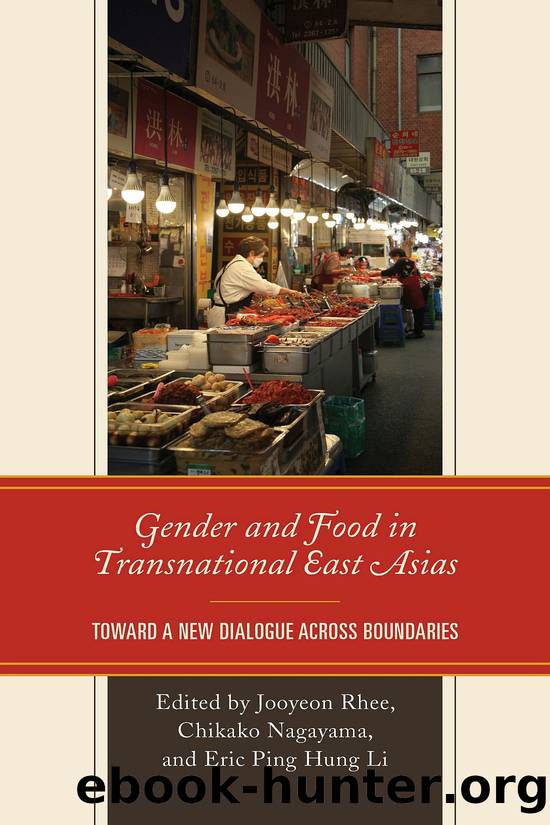Gender and Food in Transnational East Asias by Jooyeon Rhee Chikako Nagayama and Eric Ping Hung Li

Author:Jooyeon Rhee, Chikako Nagayama, and Eric Ping Hung Li
Language: eng
Format: epub
Publisher: Lexington Books
Figure 7.1 Actor Châoe Purham in a Traditional Kitchen. Korean Cuisine, January 21, 2016. Source: Photo courtesy of KBS 1.
The appreciation of womenâs domestic labor is emphasized in Châoeâs narration, starting from commenting on the cooking process to the âtaste of mothersâ loveâ embodied in the cooked dishes. The male tester rediscovers womenâs invisible labor, stressing their emotional investment in food and cooking, which is an expression of love and care for their families. The intimacy between the male tester and women in the show plays an important role for the audiencesâ experience of comfort and belonging that they lack in their everyday lives.
However, the image of these elderly women reproduces the gender stereotype about domestic cooking in the name of nostalgia and tradition. The kind of labor invested in these dishes is appreciated by the narrator but the camera hardly depicts womenâs enjoyment of food; rather, the camera shows how hard these women try to please their family.
In Korean Cuisine, the recognition for womenâs culinary expertise comes from men and women who remain in their kitchen perpetually through the visual construction of them as ajummaâa middle-aged woman with childrenâwhose femininity is solely defined by her domestic role. An ajumma is devoid of personality or individuality in the Korean context, a category of women who usually have no professions but put the family first in their lives. The camera aestheticizes womenâs motherly love, mingling the rural landscape with womenâs makeup-free, deeply wrinkled faces and simple dresses, as if they are a part of nature. The literal meaning of the title of the show is âKoreansâ dinner table,â homogenizing the ethnic identity of Koreans through food. In this context, ajumma is fetishized with a national rhetoric that ironically does not recognize them as equal at the dinner table: they are the self-sacrificing mothers and the servers whose female subjectivity is veiled behind the nostalgic flavor of food. When food comes to the dining table, it loses its universality and it becomes a symbol of inequality. Food thus represents both possibilities and constraints about our everyday lives because of its social, economic, political, and cultural systems and practices that produce such inequality.
The sense of comfort and belonging forms in rural settings away from urban environments, and this distancing strategy is a success factor for the show. Another popular show, Three Meals a Day, is a good example that emphasizes the fantasy of âreturning to nature.â All participants in Three Meals are males, mostly well-known entertainers, and they are dispatched to remote areas away from cities and given limited ingredients and cooking tools. They all live in the same house for one season and have to make three meals a day for themselves. Due to their limited supplies, they go fishing and pick herbs and vegetables from fields and mountains. Most participants have poor cooking skills and knowledge about food, but they make sincere efforts to prepare proper meals. If some members demonstrate good cooking skills, they will be praised by other members in the group.
Download
This site does not store any files on its server. We only index and link to content provided by other sites. Please contact the content providers to delete copyright contents if any and email us, we'll remove relevant links or contents immediately.
Never by Ken Follett(2878)
The Man Who Died Twice by Richard Osman(2297)
Machine Learning at Scale with H2O by Gregory Keys | David Whiting(2285)
Fairy Tale by Stephen King(2063)
Will by Will Smith(2040)
The Becoming by Nora Roberts(1330)
Friends, Lovers, and the Big Terrible Thing by Matthew Perry(1327)
A Short History of War by Jeremy Black(1299)
Go Tell the Bees That I Am Gone by Diana Gabaldon(1233)
515945210 by Unknown(1207)
443319537 by Unknown(1071)
Works by Richard Wright(1018)
Going There by Katie Couric(991)
The 1619 Project by Unknown(988)
472244821 by Unknown(983)
Living Planet by David Attenborough(897)
264099364 by Unknown(863)
386736962 by Unknown(821)
Bourdain by Laurie Woolever(798)
